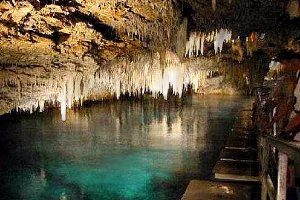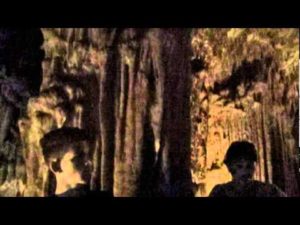LAS CUEVAS DE BELLAMAR, NUEVOS HALLAZGOS EN ESA JOYA EXCLUSIVA DE CUBA.
Son un conjunto de cavernas de mas de 23 kilómetros de galerias situadas en la provincia Matanzas, Cuba. Por la belleza de sus galería y cavernas y por nuevos hallazgos paleontológicos, además de una amplia gama de procesos cristalinos fueron declaradas Monumento Nacional.
Las galerías y pasadizos de las Cuevas de Bellamar se calcula que comenzaron a formarse hace unos 300 mil años. Según los estudiosos, la planicie en la cual están las cuevas se encontraba originalmente bajo el mar, formando parte de la bahía de Matanzas. A lo largo de la llamada Falla de Bellamar el agua subterránea, en combinación con el dióxido de carbón, fue disolviendo la roca calcárea y de esta forma fue creando cámaras subterráneas en el subsuelo; bajo el fondo marino.
Mientras permanecieron bajo el nivel del mar, estas cavernas estuvieron llenas de agua. Los movimientos tectónicos hicieron que la zona se elevara, hasta llegar a formar las terrazas marinas que se notan en la ciudad de Matanzas y sus alrededores.
Con el decursar del tiempo estas cavernas se fueron secando; desaguándose incluso algunas cavidades que están a gran profundidad bajo el nivel del mar y comenzaron a tener lugar filtraciones entre las rocas, sobre el techo de las cuevas, de agua con carbonato de cal disuelto que fueron dejando residuos al gotear y, de ese modo formar las estalactitas desde el techo y las estalagmitas en el suelo.
Llamadas originalmente las Cuevas de Parga en homenaje a su descubridor, el punto cambió su nombre por el de Las Cuevas de Bellamar, en plural, (aunque los especialistas indican que se trata de una sola cueva con varios salones) debido a su cercanía con la playa homónima en el oeste matancero.
Las estalactitas son cilíndricas, y según aumenta su tamaño se hacen cónicas mientras que las estalagmitas son cónicas o aplanadas, como derretidas. Ambas crecen hasta unirse y formar columnas. En algunos casos varias estalactitas relativamente cercas se van uniendo, dando lugar a las formaciones llamadas matos. Otras corren próximas a la pared formando cascadas. En las Cuevas de Bellamar se ven todas estas formaciones.
Dividida en cuatro sectores, sus galerías y salones están tapizados de estalactitas, estalagmitas y helictitas, estas últimas de caprichosas formas horizontales.
Nuevos descubrimientos
De relevante interés científico valoran aquí los nuevos hallazgos en un segmento del Sistema Cavernario Bellamar. En la centenaria cueva un grupo de espeleólogos descubrieron una estrecha cavidad que los condujo a otra prolongación subterránea de unos nueve kilómetros de longitud. Para sorpresa de todos, encontraron allí galerías de incomparable belleza.
Se trata de formaciones cilíndricas pendientes de estalactitas, y suspendidas en el aire, en cuyos extremos cuelgan un conglomerado de cristales macizos de calcita.Por su dimensión y rareza los especialistas consideran el descubrimiento como joya exclusiva, incomparable con ningún otro hallazgo de su tipo. Son formaciones indescriptibles, por cuanto en ningún otro lugar del planeta se conoce semejante cristalería de carbonato de calcio.
En exploraciones continuadas por el grupo espeleológico Félix Rodríguez de la Fuente, aparecieron otros descubrimientos paleontológicos de significativo interés científico, como restos de vertebrados terrestres y aves cuya antigüedad la estiman en millones años.
Entidades especializadas contabilizan a lo largo y ancho de la isla más de 10 mil cuevas, muchas de ellas con unos 25 millones de años de evolución, pero hasta nuestros días las Cuevas de Bellamar sigue siendo la reina, el centro turístico más antiguo de Cuba.
THE CAVES OF BELLAMAR, NEW FINDINGS IN THIS EXCLUSIVE JEWEL OF CUBA.
They are a group of caves of more than 23 kilometers of galleries located in the Matanzas province, Cuba. Due to the beauty of its gallery and caverns and new paleontological finds, besides a wide range of crystalline processes were declared National Monument.
The galleries and passageways of the Bellamar Caves are estimated to have begun to form about 300 thousand years ago. According to scholars, the plain in which the caves are was originally under the sea, forming part of the Bay of Matanzas. Throughout the so-called Bellamar Fault the groundwater, in combination with carbon dioxide, was dissolving calcareous rock and in this way was creating subterranean chambers in the subsoil; Under the seabed.
While they were below sea level, these caverns were filled with water. The tectonic movements caused that the zone elevated, until arriving at to form the marine terraces that are noticeable in the city of Matanzas and its environs.
With the passage of time these caverns were dried up; Even depleting some of the cavities that are deep beneath sea level, and there began to be leaks between the rocks, on the roof of the caves, water with dissolved lime carbonate, which left residues dripping and, in this way, formed The stalactites from the ceiling and the stalagmites on the floor.
Originally called the Caves of Parga in honor of its discoverer, the point changed its name to the one of Las Cuevas de Bellamar, in the plural, (although the specialists indicate that it is a single cave with several rooms) due to its proximity with the Homonymous beach in the West Matancero.
The stalactites are cylindrical, and as their size increases they become conical while the stalagmites are conical or flattened, as if melted. Both grow to join and form columns. In some cases several relatively close stalactites join together, giving rise to formations called matos. Others run close to the wall forming waterfalls. In the Caves of Bellamar you can see all these formations.
Divided into four sections, its galleries and lounges are lined with stalactites, stalagmites and helicites, the latter of whimsical horizontal forms.
New discoveries
Of relevant scientific interest, they value here the new findings in a segment of the Bellamar Cavern System. In the century-old cave a group of speleologists discovered a narrow cavity that led them to another subterranean extension of about nine kilometers in length. To everyone’s surprise, they found galleries of incomparable beauty.
These are cylindrical formations hanging from stalactites and suspended in the air, at the ends of which hang a conglomerate of massive crystals of calcite. Because of their size and rarity, specialists consider the discovery as an exclusive jewel, incomparable with no other finding of its kind. They are indescribable formations, since in no other place of the planet is known such glassware of calcium carbonate.
In continuous explorations by the speleological group Felix Rodriguez de la Fuente, other paleontological discoveries of significant scientific interest appeared, as remnants of terrestrial vertebrates and birds whose antiquity estimate in million years.
Specialized entities account for more than 10 thousand caves along the length of the island, many of them with some 25 million years of evolution, but to this day the Caves of Bellamar remains the queen, Cuba’s oldest tourist resort.
Agencies/EcuRed/Excerpts/Internet Photos/Arnoldo Varona/TheCubanHistory.com
THE CUBAN HISTORY, HOLLYWOOD.



 THE CAVES OF BELLAMAR, new findings in this exclusive Jewel of Cuba. (Photos) + LAS CUEVAS DE BELLAMAR, nuevos hallazgos en esa joya exclusiva de Cuba. (Fotos).
THE CAVES OF BELLAMAR, new findings in this exclusive Jewel of Cuba. (Photos) + LAS CUEVAS DE BELLAMAR, nuevos hallazgos en esa joya exclusiva de Cuba. (Fotos).





